Lovett Artillery - 10cm Kanone 1917 (original) (raw)
10cm. Kanone 1917
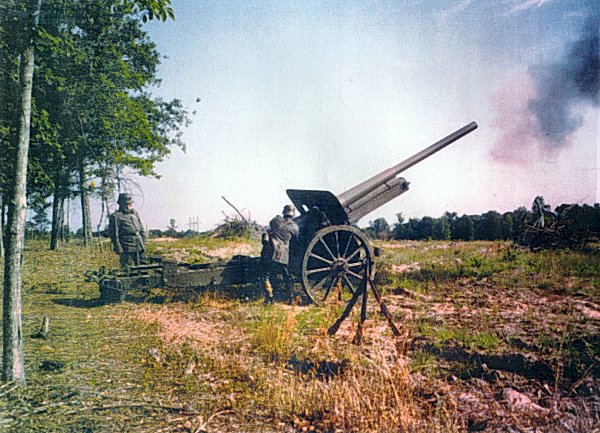
Above: Firing the 10cm Kanone 1917
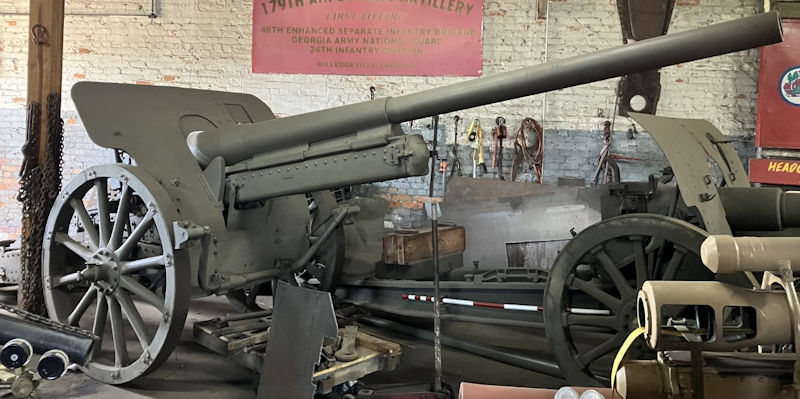
The 10cm. Kanone 1917 was the last in its line of development to see combat in WW1 and was even modern enough to serve on through WW2. 10cm. Kanonen were specifically guns for counterfire and were organized into the AKA (Artillery Countering Artillery) as opposed to the 15cm. Howitzers which were organized for fires against enemy maneuver targets.
This 10cm. Kanone �17 was in by far the poorest condition of any artillery piece acquired into Lovett collection. It is also the largest and most complicated. These three factors resulted in it proving the most difficult, time consuming and expensive to restore of any attempted so far. These photographs of its first shots only came about after six years of difficult reconstruction.
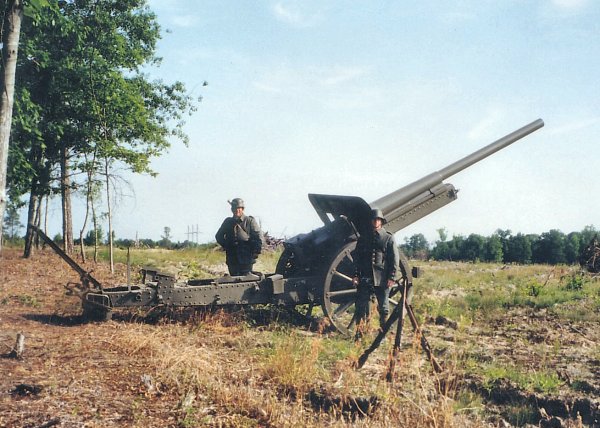
Leon and Ralph Lovett pictured with the 10cm. Kanone “17 in 1999. There are few examples of the “17 still in existence. One can be found at Ft. Sill but in inoperable poor condition with very inaccurate restoration masking over range damage. It is nick named “Simpson’s Gun”. Gonzales, Texas National Guard Armory has one in inoperable but comparatively good condition; however, it is missing its range drum/sightmount. At Coblenz, Germany a variation of this piece, the 10cm Kanone 17/04 is on display in very good restored condition, apparently operational.
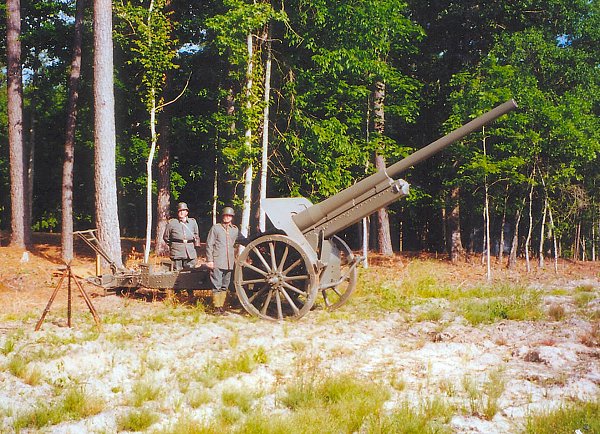
The 10cm “17 is a massive artillery piece. Two men can fire it but to move it around a large crew with horses are nearly essential. In our case, a tractor and a White half-track were necessary to emplace the Kanone.
This is the Gunner's Quadrant set on the Breech Ring of the K."17
This is the shell case and projectile fitted with a PD fuze. The fuze setter is used to set time fuzes not for the PD fuze pictured.
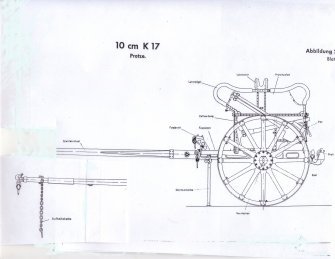
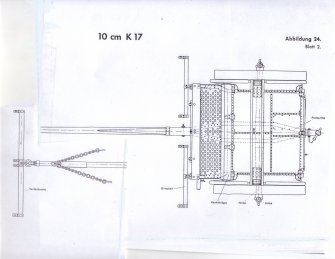
Above are views of the 10cm K 17 Limber
**10cm Kanone 1917 & 1917/04
(by CW2 Ralph Lovett)
**In its artillery role, the 10cm Kanone 1914 proved effective in combat and generated much interest in a longer-range piece along similar lines. The necessarily longer barrel, to provide this increased range meant greater weight. Keeping in mind that the primary means of transporting these pieces was a six-horse team; a suggestion was made by the Artillery Armament Agency to Krupp’s Professor Rausenberger to separate this larger barrel from the carriage during transport. By using many of the components of the K.”14, lengthening the barrel and simplifying the breech to a basic manual horizontal sliding wedge type the new 10cm Kanone 1917 design evolved. There was no requirement for the K.”17 to provide an anti-aircraft role. In spite of dropping the anti-aircraft mission and the need to simplify the new gun, it retained most of the extremely complicated and heavy devices to make it perform against aircraft. The double elevation system, 45-degree elevation, variable recoil, and the attachments for fitting the 360-degree traversing platform were all retained. A more powerful equilibrator (Ausgleicher) was added to check the increased barrel weight and length. Removable ramps, which penned to stationary, carriage-mounted rails, were fitted to the rear of the carriage. These guides were matched with the barrel cart (rohrkarren). This barrel cart was essentially a recoil sleigh, minus its internal workings, mounted on an axle. A manual winch, much like those found on modern boat trailers, drew the barrel off the recoil sleigh and onto the barrel cart. I am unaware of a K.”17 barrel cart in existence today, however, Ft. Sill’s K.”17 still has ramps affixed (riveted) to the rear of the carriage. The same wheel and brake types were used as those found on the gun. The range drum (Zieleinrichtung) of the K.”14 was changed from the right side on the K.”14 to the left on the K.”17. In this way the sight, sight-mount and range drum were combined into one component. Linkage for this device was then run under the barrel. As with most German pieces of the era, the K. "17 has an auxiliary mount for the 0-5800 semicircumferentor or half-circle sight (Richtkreis) on the breech face. The K.'14 evidently did not have this mount, probably because of the protruding semi-automatic breech device on top of the breech ring. The range drum, as it would normally be called is in fact more a range"disk", with degrees of elevation (0-45) indicated on a vertical disk. So far as I know, the K.”17-range disk-sight mount in my collection is the only complete one to survive today. The 10cm K.”17 fired semi-fixed ammunition and had a maximum range of 14,100 meters. Each battery was comprised of only three guns. This was effective because of the high rate of fire characteristic of the K.”17. Horse transport was fairly effective with the K.”17 broken down into two loads. Motor transport of this piece was also sometimes utilized. There were even plans to remount the K.”17 on an automotive suspension. This might have been the end of the 10cm gun development within the Great War if it were not for a need to simplify the extremely complicated K.”17. Roughly at the same time design work started on the K.”17 an order was put in for the manufacture of 1000 more K.”04s. The K.”04 was chosen over the K.”14 or the potential of the new K.”17 because of its simplicity and relative ease of manufacture. In spite of this logic, the Artillery Armament Test Agency did not want this order completed because of the advances seen in testing the new K.”17. A compromise was made to simplify the K.”17 by dropping the complex sighting system with a system basically the same as that in use with the 15cm s.F.H. 1913. Recoil was made easier to manufacture and maintenance by eliminating variable recoil. As with the K."17 both hydro-spring (Rohrbremse mit Federvorholer) and hydro-pneumatic (rohrbremse mit luftvorholer) type recoils were utilized. No change of designation was made regardless of recoil type. No provision was made for dividing the gun into two loads for transport. Professor Rausenberger took little time to make these modifications and the new Kanone 1917/04 was ordered in August 1917. The extremely heavy and complicated dual elevation mechanism was deleted. The left-hand side, sight elevation mechanism was retained, although it was most likely re-geared for a lower turn to elevation ratio. A well-preserved example of a Kanone 1917/04 can be seen at Koblenz’s Wehrtechnische Studiensammlung
**The 10cm design was not envisioned in exactly the niche it ultimately filled. It first was seen as a fortress or siege weapon. It was then developed as a quick fire; long range fortress and field artillery piece with its expected secondary mission to be an anti-aircraft weapon. It had the advantage of common ammunition with the Imperial Navy. It also benefited greatly from the development of high explosives and chemical munitions, to multiply its bursting radius. At he same time it suffered from poor dispersion characteristics, small bore size, and transport complications. Even Bruchmueller, in his 1922 work, says of the 10cm, that it was looked on by howitzer batteries like a stepmother (Stiefmuetterlich) looks at the other child. Also, the 10cm developed into a difficult piece to manufacture largely because of its perceived value as an anti-aircraft weapon. Despite a few K.”04s downing balloons during the war, these pieces never fulfilled a useful air defense niche. In 1914 few active army corps had heavy guns within their organization. Often these pieces were found in the reserve units. By 1918 all corps incorporated heavy guns. The Foot Artillery organization was typically made of a mixture of two howitzer batteries, with one battery of heavy guns per Foot Artillery Battalion. Overall it appears the 10cms did find useful service. They served as an excellent long-range counter battery weapon and were more than passable as an anti-personnel weapon. They were well paired with the 15cms, which did more commonly serve in the anti-personnel role. As final evidence of their value, the Kanone 1917 and K."17/04 soldered on with the Reichswehr and Wehrmacht. The 10cm Kanone series continued with the 10cm Kanone18, and these three most modern types even saw excellent service though out the Second World War .
****(See the "Development of the German 10cm" page for more information)**
10cm Kanone 1917 Image Gallery
(click on the thumbnail for larger image)
All images, research, and text are sole property of Ralph Lovett.